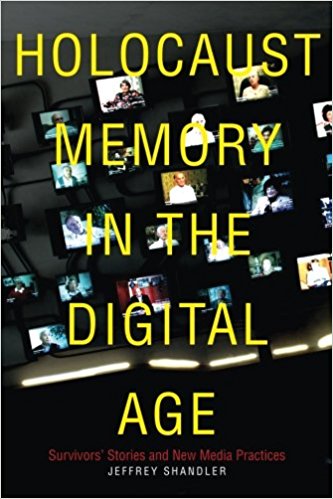Former Research Fellow Jeffrey Shandler Publishes New Book on Visual History Archive: “Holocaust Memory in the Digital Age”

 Four years after completing a visiting fellowship at USC Shoah Foundation and seven years after he was first introduced to the Visual History Archive, Professor Jeffrey Shandler’s extensive research into the Visual History Archive has culminated in a new book: Holocaust Memory in the Digital Age: Survivors’ Stories and New Media Practices (Stanford University Press).
Four years after completing a visiting fellowship at USC Shoah Foundation and seven years after he was first introduced to the Visual History Archive, Professor Jeffrey Shandler’s extensive research into the Visual History Archive has culminated in a new book: Holocaust Memory in the Digital Age: Survivors’ Stories and New Media Practices (Stanford University Press).
The book delves into the possibilities, challenges, and unique findings in USC Shoah Foundation’s Visual History Archive, which currently holds nearly 54,000 testimonies of Holocaust survivors and witnesses. The vast majority of the testimonies were recorded in the mid-1990s when the Shoah Foundation was first founded following the release of Steven Spielberg’s film Schindler’s List.
Shandler, a professor of Jewish Studies at Rutgers University, recalls being introduced to the Shoah Foundation and its Visual History Archive in 2010, when the foundation’s former executive director Doug Greenberg became Executive Dean of the Rutgers School of Arts and Sciences. Shandler was fascinated by how the archive could be used to study not just what Holocaust survivors recalled in their testimonies, but how they recalled their past.
“The archive isn’t just a repository of tens of thousands of memories, it’s a memory work in its own right. It’s shaped by a particular time and by the particular media and the subjects involved,” Shandler said. “As I became familiar with its holdings, I kept looking in different corners of the archive to learn about the various ways survivors remember.”
Shandler was awarded a USC Shoah Foundation Institute Fellowship in 2013 and spent several months in residence at the Institute, consulting with staff and watching hundreds of testimonies. His first major study of the archive focused on survivors’ discussions of Schindler’s List, which he found to be quite surprising, complex and thoughtful. Shandler has also focused on other topics, ranging from the language in which survivors were interviewed to the impact of the archive’s digital nature on how their remembrance is mediated.
Shandler noted that, as a scholar of Yiddish, the archive’s 600-plus Yiddish-language testimonies are of particular interest to him. He was also struck by the fact that, of all the testimonies in the archive given in two languages, English and Yiddish is the most common combination. In many of these interviews, survivors start out speaking in English but then switch to Yiddish at some point during their testimony.
“This got me thinking about the role of language in these interviews generally,” Shandler said. “Most Jewish Holocaust survivors used more than one language in the course of their lives, yet they’re asked to tell their life story in one language. But in some cases that request proved limiting and they felt compelled to switch to another language. What can we learn from that?”
Another part of the book discusses how some survivors display scars from wartime injuries during their testimonies, sometimes removing clothing and allowing the camera to zoom in close on their wounds.
“These are very powerful moments, in part because it’s not what you expect to see in interviews that are in the form of ‘talking heads,’” Shandler said.
By focusing on some of the more surprising and less-discussed aspects of the Visual History Archive, Shandler wants to widen people’s perspectives on the diverse wealth of material it offers.
“Looking at these exceptional moments helped me think about how the archive works as a whole,” he said. “I’m hoping that when people read the book they’ll also reflect on whatever assumptions they might have about how Holocaust survivors remember the past and will go to the archive with a greater sense of how to think about what they see and hear in it.”
Like this article? Get our e-newsletter.
Be the first to learn about new articles and personal stories like the one you've just read.